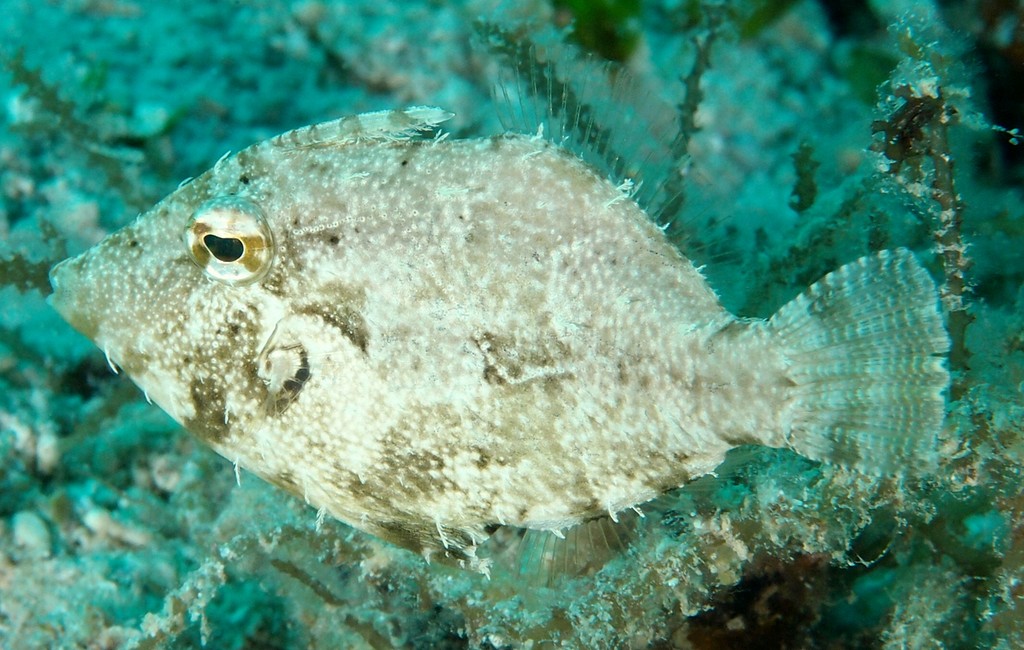PARAMONACANTHUS CHOIROCEPHALUS - (BLEEKER, 1851)
Actinopterygii (Gigaclass) > Actinopteri (Class) > Teleostei (Subclass) > Tetraodontiformes (Order) > Balistoidei (Suborder) > Monacanthidae (Family) > Paramonacanthus (Genus)
Pig faced leather jacket, White-blotched filefish, Sima-Nagahagi,
Synonymes
Monacanthus choirocephalus (Bleeker, 1851)
Monacanthus nemurus (Bleeker, 1851)
Paramonacanthus nemurus (Bleeker, 1851)
Paramonacanthus whitleyi (Fraser-Brunner, 1941)
Stephanolepis retrospinis (Fowler, 1943)
---------------------------------------------
Description
Dorsal spines (total): 2; Dorsal soft rays (total): 27-31; Anal spines: 0; Anal soft rays: 28 - 32; Vertebrae: 19. Dorsal profile of snout straight to convex in male, small hump sometimes over or slightly in advance of nostrils; straight to concave in female and juvenile, without hump. First dorsal spine originating over posterior half of eye, or slightly behind eye. With dark brown to dusky blotches, sometimes tending to form two curved, oblique stripes on body, first from rear of soft dorsal fin to pectoral fin, second from caudal fin base to ventral flap; three dark brown blotches nearly always present. Max length : 11.0 cm. Depth range 3 - 25 m.
Etymology
Paramonacanthus: from Greek, para = the side of + Greek, monos = one + Greek, akantha = thorn.
choirocephalus: from Greek, choiros = pig, and -cephalus (noun combining form) from Greek "-kephalos" = head.
Distribution
Western Pacific: Thailand, Malaysia, northwestern Australia, Philippines, Indonesia, and New Guinea. Reported from New Caledonia.
Biology
Inhabits sheltered coastal reefs, usually forming small aggregations. Also found in mud and sand bottoms of trawling grounds.
Similar species
Paramonacanthus otisensis (Whitley, 1931) - Max length : 11.0 cm SL. Depth range 5 - 36 m. Adult caudal fin with moderately long filaments on upper and middle rays. Pelvic fin rudiment movable, small; pelvic flap moderately extendable. Pale grey or yellow to brown with variable dark markings. Distribution - Southwest Pacific: Eastern Australia. Found in weedy areas, usually in harbors.
Acreichthys tomentosus (Linnaeus, 1758) reported from New Caledonia.
Paramonacanthus curtorhynchos (Bleeker, 1855) reported from New Caledonia.
Pig faced leather jacket, White-blotched filefish, Sima-Nagahagi,
Synonymes
Monacanthus choirocephalus (Bleeker, 1851)
Monacanthus nemurus (Bleeker, 1851)
Paramonacanthus nemurus (Bleeker, 1851)
Paramonacanthus whitleyi (Fraser-Brunner, 1941)
Stephanolepis retrospinis (Fowler, 1943)
---------------------------------------------
Description
Dorsal spines (total): 2; Dorsal soft rays (total): 27-31; Anal spines: 0; Anal soft rays: 28 - 32; Vertebrae: 19. Dorsal profile of snout straight to convex in male, small hump sometimes over or slightly in advance of nostrils; straight to concave in female and juvenile, without hump. First dorsal spine originating over posterior half of eye, or slightly behind eye. With dark brown to dusky blotches, sometimes tending to form two curved, oblique stripes on body, first from rear of soft dorsal fin to pectoral fin, second from caudal fin base to ventral flap; three dark brown blotches nearly always present. Max length : 11.0 cm. Depth range 3 - 25 m.
Etymology
Paramonacanthus: from Greek, para = the side of + Greek, monos = one + Greek, akantha = thorn.
choirocephalus: from Greek, choiros = pig, and -cephalus (noun combining form) from Greek "-kephalos" = head.
Distribution
Western Pacific: Thailand, Malaysia, northwestern Australia, Philippines, Indonesia, and New Guinea. Reported from New Caledonia.
Biology
Inhabits sheltered coastal reefs, usually forming small aggregations. Also found in mud and sand bottoms of trawling grounds.
Similar species
Paramonacanthus otisensis (Whitley, 1931) - Max length : 11.0 cm SL. Depth range 5 - 36 m. Adult caudal fin with moderately long filaments on upper and middle rays. Pelvic fin rudiment movable, small; pelvic flap moderately extendable. Pale grey or yellow to brown with variable dark markings. Distribution - Southwest Pacific: Eastern Australia. Found in weedy areas, usually in harbors.
Acreichthys tomentosus (Linnaeus, 1758) reported from New Caledonia.
Paramonacanthus curtorhynchos (Bleeker, 1855) reported from New Caledonia.
